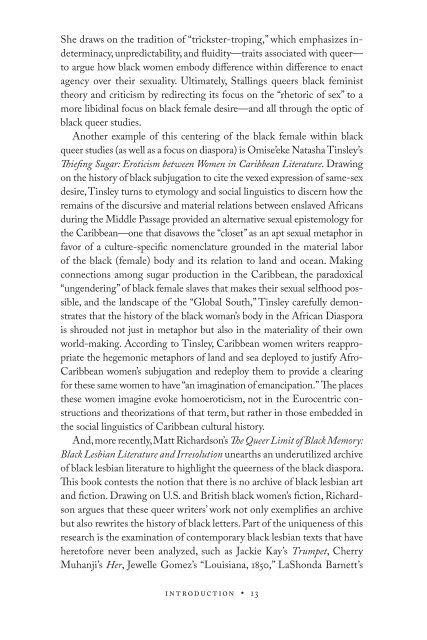No Tea
89AS6wvrf
89AS6wvrf
You also want an ePaper? Increase the reach of your titles
YUMPU automatically turns print PDFs into web optimized ePapers that Google loves.
She draws on the tradition of “trickster- troping,” which emphasizes indeterminacy,<br />
unpredictability, and fluidity— traits associated with queer—<br />
to argue how black women embody difference within difference to enact<br />
agency over their sexuality. Ultimately, Stallings queers black feminist<br />
theory and criticism by redirecting its focus on the “rhe toric of sex” to a<br />
more libidinal focus on black female desire— and all through the optic of<br />
black queer studies.<br />
Another example of this centering of the black female within black<br />
queer studies (as well as a focus on diaspora) is Omise’eke Natasha Tinsley’s<br />
Thiefing Sugar: Eroticism between Women in Ca rib bean Lit er a ture. Drawing<br />
on the history of black subjugation to cite the vexed expression of same- sex<br />
desire, Tinsley turns to etymology and social linguistics to discern how the<br />
remains of the discursive and material relations between enslaved Africans<br />
during the Middle Passage provided an alternative sexual epistemology for<br />
the Caribbean— one that disavows the “closet” as an apt sexual meta phor in<br />
favor of a culture- specific nomenclature grounded in the material labor<br />
of the black (female) body and its relation to land and ocean. Making<br />
connections among sugar production in the Ca rib bean, the paradoxical<br />
“ungendering” of black female slaves that makes their sexual selfhood possi<br />
ble, and the landscape of the “Global South,” Tinsley carefully demonstrates<br />
that the history of the black woman’s body in the African Diaspora<br />
is shrouded not just in meta phor but also in the materiality of their own<br />
world- making. According to Tinsley, Ca rib bean women writers reappropriate<br />
the hegemonic meta phors of land and sea deployed to justify Afro-<br />
Caribbean women’s subjugation and redeploy them to provide a clearing<br />
for these same women to have “an imagination of emancipation.” The places<br />
these women imagine evoke homoeroticism, not in the Eurocentric constructions<br />
and theorizations of that term, but rather in those embedded in<br />
the social linguistics of Ca rib bean cultural history.<br />
And, more recently, Matt Richardson’s The Queer Limit of Black Memory:<br />
Black Lesbian Lit er a ture and Irresolution unearths an underutilized archive<br />
of black lesbian lit er a ture to highlight the queerness of the black diaspora.<br />
This book contests the notion that there is no archive of black lesbian art<br />
and fiction. Drawing on U.S. and British black women’s fiction, Richardson<br />
argues that these queer writers’ work not only exemplifies an archive<br />
but also rewrites the history of black letters. Part of the uniqueness of this<br />
research is the examination of con temporary black lesbian texts that have<br />
heretofore never been analyzed, such as Jackie Kay’s Trumpet, Cherry<br />
Muhanji’s Her, Jewelle Gomez’s “Louisiana, 1850,” LaShonda Barnett’s<br />
Introduction • 13


